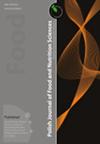Optimization of Ultrasound Treatment of Beverage from Mango and Carrot with Added Turmeric Using Response Surface Methodology
IF 2.3
4区 农林科学
Q3 FOOD SCIENCE & TECHNOLOGY
引用次数: 2
Abstract
phenolic content (TSP), total carotenoid content (TC) and antioxidant capacity (AOC) was evaluated. Response surface methodology (RSM) was applied to obtain the optimal formulation of the beverage. The AOC was assigned as a response variable in addition to TSP and TC. Mathematical modeling showed that the formulation with 35% ( v/v ) of mango pulp, 10% ( v/v ) of carrot juice, and 0.7% ( w/v ) of turmeric powder, yielded the highest values of TSP, TC, and AOC. The beverages were subjected to different ultrasound conditions with varying exposure times (ET), sonication amplitudes (SA), and pulse cycles (PC) to obtain the highest values for response variables. Statistical modeling showed that a UT at 21 min ET, 100% SA, and 0.7 s PC, increased TSP, Trolox equivalent antioxidant capacity (TEAC), and ferric reducing antioxidant power (FRAP) by 15.5%, 45.1%, and 15.9%, respectively. Seven phenolic acids, three curcuminoids, five flavonoids, and a xanthonoid were identified in the beverages. The quantities of 3,4-dihydroxybenzoic acid, gallic acid, chlorogenic acids, (+)-catechin, quercetin, kaempferol, (–)-gallocatechin gallate, and mangiferin were higher in the UT beverage compared to the control, suggesting their release from cell-wall structures as a result of UT. acid), FRAP, ferric reducing antioxidant power, TPTZ, 2,4,6-tripyridyl- s -triazine; GAE, gallic acid equivalent; TE, Trolox equivalent.响应面法优化添加姜黄的芒果和胡萝卜饮料的超声处理
测定其酚类含量(TSP)、总类胡萝卜素含量(TC)和抗氧化能力(AOC)。采用响应面法(RSM)确定了该饮料的最佳配方。除TSP和TC外,AOC被指定为响应变量。数学建模结果表明,当芒果浆用量为35% (v/v)、胡萝卜汁用量为10% (v/v)、姜黄粉用量为0.7% (w/v)时,其TSP、TC和AOC的含量最高。在不同的暴露时间(ET)、超声振幅(SA)和脉冲周期(PC)条件下,对饮料进行不同的超声处理,以获得响应变量的最大值。统计模型显示,在ET为21 min、SA为100%和PC为0.7 s时,UT可使TSP、Trolox当量抗氧化能力(TEAC)和铁还原抗氧化能力(FRAP)分别提高15.5%、45.1%和15.9%。在饮料中鉴定出7种酚酸、3种姜黄素、5种黄酮类化合物和1种黄嘌呤类化合物。与对照组相比,UT饮料中3,4-二羟基苯甲酸、没食子酸、绿原酸、(+)-儿茶素、槲皮素、山酚、(-)-没食子儿茶素没食子酸酯和芒果苷的含量更高,这表明它们从细胞壁结构中释放出来是UT的结果。酸)、FRAP、铁还原抗氧化能力、TPTZ、2,4,6-三吡啶- 5 -三嗪;GAE,没食子酸当量;TE, Trolox当量。
本文章由计算机程序翻译,如有差异,请以英文原文为准。
求助全文
约1分钟内获得全文
求助全文
来源期刊

Polish Journal of Food and Nutrition Sciences
FOOD SCIENCE & TECHNOLOGY-
CiteScore
4.30
自引率
12.50%
发文量
25
审稿时长
20 weeks
期刊介绍:
The Polish Journal of Food and Nutrition Sciences publishes original, basic and applied papers, reviews and short communications on fundamental and applied food research in the following Sections:
-Food Technology:
Innovative technology of food development including biotechnological and microbiological aspects
Effects of processing on food composition and nutritional value
-Food Chemistry:
Bioactive constituents of foods
Chemistry relating to major and minor components of food
Analytical methods
-Food Quality and Functionality:
Sensory methodologies
Functional properties of food
Food physics
Quality, storage and safety of food
-Nutritional Research Section:
Nutritional studies relating to major and minor components of food (excluding works related to questionnaire
surveys)
-“News” section:
Announcements of congresses
Miscellanea
 求助内容:
求助内容: 应助结果提醒方式:
应助结果提醒方式:


